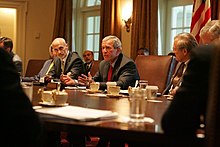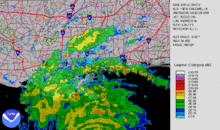Preparations
Main article: Preparations for Hurricane Katrina
Federal government
On the afternoon of August 26, the NHC realized that Katrina had yet to make the turn toward the Florida Panhandle and ended up revising the predicted track of the storm from the panhandle to the Mississippi coast.[9] The NHC issued a hurricane watch for southeastern Louisiana, including the New Orleans area at 1500 UTC on August 27. Later that day, NHC extended the watch to cover the Mississippi and Alabama coastlines as well as the Louisiana coast to Intracoastal City.[1]
The United States Coast Guard began pre-positioning resources in a ring around the expected impact zone and activated more than 400 reservists. On August 27, it moved its personnel out of the New Orleans region prior to the mandatory evacuation.[10] Aircrews from the Aviation Training Center, in Mobile, staged rescue aircraft from Texas to Florida.[11] All aircraft were returning towards the Gulf of Mexico by the afternoon of August 29. Aircrews, many of whom lost their homes during the hurricane, began a round-the-clock rescue effort in New Orleans, and along the Mississippi and Alabama coastlines.[12]
President of the United States George W. Bush declared a state of emergency in selected regions of Louisiana, Alabama and Mississippi on August 27.[13] That same evening, the NHC upgraded the storm alert status from hurricane watch to hurricane warning over the stretch of coastline betweenMorgan City, Louisiana, to the Alabama–Florida border, 12 hours after the watch alert had been issued, and also issued a tropical storm warning for the westernmost Florida Panhandle.[1]
During video conferences involving the president on August 28 and August 29, NHC director Max Mayfield expressed concern that Katrina might push its storm surge over the city's levees and flood walls. In one conference, he stated, "I do not think anyone can tell you with confidence right now whether the levees will be topped or not, but that's obviously a very, very great concern."[14]
On Sunday, August 28, as the sheer size of Katrina became clear, the NHC extended the tropical storm warning zone to cover most of the Louisiana coastline and a larger portion of theFlorida Panhandle. The National Weather Service's New Orleans/Baton Rouge office issued a vividly worded bulletin predicting that the area would be "uninhabitable for weeks" after "devastating damage" caused by Katrina, which at that time rivaled the intensity of Hurricane Camille.[15] "On Sunday, August 28, President Bush spoke with Governor Blanco to encourage her to order a mandatory evacuation of New Orleans."[16]
Voluntary and mandatory evacuations were issued for large areas of southeast Louisiana as well as coastal Mississippi and Alabama. About 1.2 million residents of the Gulf Coast were covered under a voluntary or mandatory evacuation order.[1]
Investigation of State of Emergency declaration
In a hearing on September 26, former FEMA chief Michael Brown testified before a U.S. House subcommittee about FEMA's response. During that hearing, Representative Stephen Buyer(R-IN) inquired as to why President Bush's declaration of state of emergency of August 27 had not included the coastal parishes of Orleans, Jefferson and Plaquemines.[17] (In fact, the declaration did not include any of Louisiana's coastal parishes, whereas the coastal counties were included in the declarations for Mississippi and Alabama.[18][19] Brown testified that this was because Louisiana Governor Blanco had not included those parishes in her initial request for aid, a decision that he found "shocking." After the hearing, Blanco released a copy of her letter, which showed she had requested assistance for "all the southeastern parishes including the City of New Orleans" as well specifically naming 14 parishes, including Jefferson, Orleans and Plaquemines.[20]
Gulf Coast
On August 26, the state of Mississippi activated its National Guard in preparation for the storm's landfall. Additionally, the state government activated its Emergency Operations Center the next day, and local governments began issuing evacuation orders. By 6:00 pm CDT on August 28, 11 counties and cities issued evacuation orders, a number which increased to 41 counties and 61 cities by the following morning. Moreover, 57 emergency shelters were established on coastal communities, with 31 additional shelters available to open if needed.[7] Louisiana's hurricane evacuation plan calls for local governments in areas along and near the coast to evacuate in three phases, starting with the immediate coast 50 hours before the start of tropical storm force winds. Persons in areas designated Phase II begin evacuating 40 hours before the onset of tropical storm winds and those in Phase III areas (including New Orleans) evacuate 30 hours before the start of such winds.[21]
Many private caregiving facilities that relied on bus companies and ambulance services for evacuation were unable to evacuate their charges because they waited too long. Louisiana's Emergency Operations Plan Supplement 1C (Part II, Section II, Paragraph D) calls for use of school and other public buses in evacuations.[22] Although buses that later flooded were available to transport those dependent upon public transportation, not enough bus drivers were available to drive them as Governor Blanco did not sign an emergency waiver to allow any licensed driver to transport evacuees on school buses.[23] However, 20 year old Jabbar Gibson armed with only a standard operator's permit took it upon himself to take a school bus and drive it to Houston with 50 to 70 evacuees.[24][25] Some estimates claimed that 80% of the 1.3 million residents of the greater New Orleans metropolitan area evacuated, leaving behind substantially fewer people than remained in the city during the Hurricane Ivan evacuation.[26]
By Sunday, August 28, most infrastructure along the Gulf Coast had been shut down, including all freight and Amtrak rail traffic into the evacuation areas as well as the Waterford Nuclear Generating Station.[27] The NHC maintained the coastal warnings until late on August 29, by which time Hurricane Katrina was over central Mississippi.[1]
City of New Orleans
See also: Hurricane preparedness for New Orleans
By August 26, the possibility of unprecedented cataclysm was already being considered. Many of the computer models had shifted the potential path of Katrina 150 miles (240 km) westward from the Florida Panhandle, putting the city of New Orleans directly in the center of their track probabilities; the chances of a direct hit were forecast at 17%, with strike probability rising to 29% by August 28.[28] This scenario was considered a potential catastrophe because some parts of New Orleans and the metro area are below sea level. Since the storm surge produced by the hurricane's right-front quadrant (containing the strongest winds) was forecast to be 28 feet (8.5 m), emergency management officials in New Orleans feared that the storm surge could go over the tops of levees protecting the city, causing major flooding.[29]
At a news conference at 10 am on August 28, shortly after Katrina was upgraded to a Category 5 storm, New Orleans mayor Ray Naginordered the first-ever mandatory evacuation of the city, calling Katrina "a storm that most of us have long feared."[30] The city government also established several "refuges of last resort" for citizens who could not leave the city, including the massive Louisiana Superdome, which sheltered approximately 26,000 people and provided them with food and water for several days as the storm came ashore.[31][32]



No comments:
Post a Comment